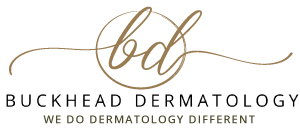Are you one of the 40 to 50 million Americans who suffer from acne?
As one of the most common skin disorders in the United States, acne can present in teenagers and adults of any skin tone. It can develop on the face, chest, back or shoulders. For those who experience moderate to severe acne on their faces, it can result in adverse emotional effects.
Although there is a great deal of information available about acne and the causes and treatments for it, much of the information is incorrect. If you are experiencing breakouts or chronic acne, it is best to consult with a board-certified dermatologist.
Dr. Sherrie-Ann Straughn of Buckhead Dermatology in Atlanta, Georgia has been successfully treating patients with acne for over 20 years. She specializes in treating acne and post-inflammatory hyperpigmentation in skin of color and is an active member of the Skin of Color Society.
What Causes Acne?
Anyone can get acne. Although most commonly seen in teenagers, many adults are experiencing late-onset acne well into their 30s and 40s. Many factors could contribute to the development of acne, including:
- Hormonal changes during puberty or menstruation
- High-stress levels
- Genetic predisposition to acne
- Irritants such as makeup, hair products or pollution
- Sweaty or dirty clothing such as hats or sports equipment
A blemish forms when the dead skin cells inside of a pore do not rise to the surface of the skin and shed as they are supposed to. Instead, the cells mix with oils in the skin and a bacteria called P. acnes resulting in inflammation.
Types of Acne
Whiteheads: Also called closed comedones, whiteheads develop from a buildup of sebum and dead skin cells. As the name suggests, whiteheads will have a white appearance.
Blackheads: Like whiteheads, blackheads are a buildup of sebum, dead skin cells and bacteria. The difference is that blackheads are open comedones, meaning that the oils inside the blemish have been exposed to oxygen and have turned dark in color.
Papules: Papules are small, raised bumps that appear on the skin. They are red and swollen, and often more painful than whiteheads and blackheads.
Pustules: A pustule is an inflamed, pus-filled pimple. They are often very red and have a pus-filled top.
Cysts: A more severe type of acne, cysts are pus-filled pimples that form deep under the skin. They are often very painful and can take a long time to heal.
Nodules: Similar to cysts, nodules form deep within the skin and can be very painful. Nodules typically feel hard to the touch and often do not appear red like other blemishes.
Treatment for Acne
Treatment for acne can vary greatly depending on the person and the type of acne they are experiencing. What works for one person may not work for another. The good news is that most cases of acne can be treated successfully, even the most severe. If you are struggling to control your acne, it is best to visit a dermatologist instead of using internet research or word-of-mouth to treat your skin condition.
A skilled dermatologist will evaluate your skin to determine the type of acne you are experiencing. Your doctor will also learn more about your medical history to determine which factors may be contributing to your blemishes. The goal of acne treatment is to clear current blemishes while preventing new ones from appearing. There are a variety of ways your doctor may treat your specific skin condition.
For mild cases, your dermatologist may recommend prescription topical medications such as retinoids, benzoyl peroxide, salicylic acid or antibiotics. Because hormones can play a role in acne breakouts, your doctor may suggest hormonal treatments such as oral contraceptives. You may be prescribed a course of oral antibiotics to help reduce inflammation and kill acne-causing bacteria.
In addition to medications, there are a variety of skin treatments available that can help treat and prevent blemishes. The most common procedures used today include laser and light treatments and chemical peels.
5 Tips for Managing Acne
For anyone that struggles with acne, it can be more than just a cosmetic issue. Many people feel frustrated, embarrassed and self-conscious about their skin resulting in low self-esteem and depression. In addition to working with your dermatologist, there are things you can do to help prevent new breakouts and effectively treat current breakouts to avoid scarring or discoloration.
- Do not pick. Picking or squeezing blemishes can re-introduce bacteria into the pore. Not only can the blemish last much longer, it can cause unwanted scarring or discoloration.
- Avoid harsh hair and skin products. Thick lotions, creams and oils may clog pores and lead to breakouts. Simple skincare is usually better if you suffer from acne.
- Do not over-treat your acne. When faced with a large blemish, there is a tendency to apply and re-apply topical medications and other treatments in the hopes of it healing faster. Too much medication can actually irritate the skin and prevent it from healing.
- Practice proper nutrition and hydration. The better we treat our bodies by eating well and drinking plenty of water, the better our skin will look. By choosing healthy foods, we are giving our bodies the ingredients it needs to heal.
- Wear sunscreen. Sun protection is essential for everyone, but especially those who suffer from acne. Too much sun exposure can increase the appearance of dark spots.
